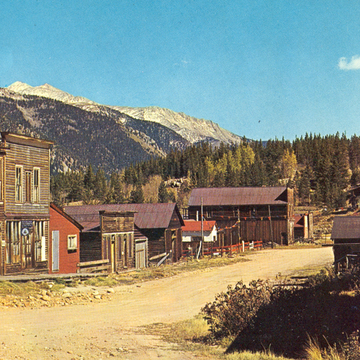St. Elmo, one of the West's best-preserved ghost towns, hosted several hundred miners from the 1880s to the 1910s. Sited on Chalk Creek in a spectacular and isolated mountain valley, this mining and milling town is surrounded by deep forests, which inspired its original name, Forest City. The second name came from pioneer storekeeper Griffith Evans, who fancied Augusta Jane Evans's sentimental novel, Saint Elmo. He hired L. C. Cornwell, a civil engineer, to survey the site and design a town plan. Cornwell imposed a gridiron of right-angled streets and rectangular blocks that ignored both branches of Chalk Creek and equally serpentine Grizzly Creek, as well as the hilly outskirts of town. Because the plan was impractical and rendered many lots useless, even the town fathers came to ignore it. Buildings were allowed in street right-of-ways, creating irregular setbacks and roadways.
Carpenter Frederick W. Brush built many of the commercial and residential buildings in St. Elmo. Two fires during the 1890s destroyed much of the business district, including the opera house. Forty-three nineteenth-century structures survive in this rare concentration of log and balloon-frame buildings that were the town's first and only generation of architecture.
Log cabins varied with the regional and ethnic origins of their builders. The McKenzie-Ottoson House (c. 1885), on the east side of Poplar Street across from the Pawnee Mill, is made of peeled logs joined in saddle notches with mud chinking. It has gable ends dressed with vertical planks, showing an Anglo propensity for making the gable end the facade. The Helmer-Savard House (c. 1888), on the south side of Gunnison Avenue four doors west of 1st Avenue, is a side-gabled house with board-and-batten gable ends and V-notched logs.
Decades after everyone else left, one family, the Starks, stayed on to run their store and guard the town against the depredations that leveled the nearby towns of Alpine, Hancock, Iron City, and Romley. Only after Tony Stark was taken to the state mental hospital in Pueblo and his wife, Annabelle, to a Salida nursing home did St. Elmo become a ghost. In recent decades, some of the old homes have been converted to summer cabins, whose residents have restored the plank sidewalks, town halls, school, jail, and Home Comfort Hotel. In the surrounding Chalk Creek Mining District, many mine, mill, railroad, and house ruins linger.






